Kadalundi-Vallikkunnu Community Reserve is endowed with diverse flora. The vegetation of the KVCR include 326 species of plants which include 168 species of medicinal value, 41 weeds, 29 ornamental plants, 26 crops,11 timber species etc.
The list of flora is given below.
More about Mangrove species
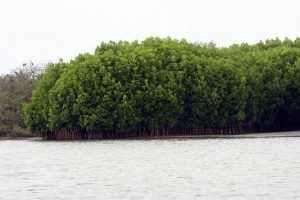 |
Family | Rhizophoraceae |
| Order | Malpighiales | |
| Common name | Red Mangrove | |
| Vernacular name | പ്രാന്തൻ കണ്ടൽ ,പീക്കണ്ടൽ | |
|
Rhizophora mucronata is a small to medium sized evergreen tree growing to a height of about 20 to 25 metres on the bank of rivers, on the fringes of the sea. They are characterised by the presence of a large number of stilt roots by which it firmly holds on to the muddy substratum. The flowering period of Rhizophora is December to June. The flowers are creamy white. The fruit is single seeded, up to 2.5 cm long and germinates while still on the tree, a phenomenon called viviparous germination. The radicle gradually protrudes from the fruit and grows into a rod- like structure. The seedling later falls from the tree to the mud and begins to grow. |
||
| Bruguiera cylindrica (L.)BI. | |
| Family Order Common name Vernacular name |
: Rhizophoraceae : Malpighiale : White Burma mangrove : കുറ്റികണ്ടൽ |
 Bruguiera cylindrica is an ever green shrub or a tree that can grow up to 15 to 20 metre tall.Leaves are light green.Presence of numerous pneumatophores (breathing roots) is one of the identifying feature of this plant. Bruguiera cylindrica is an ever green shrub or a tree that can grow up to 15 to 20 metre tall.Leaves are light green.Presence of numerous pneumatophores (breathing roots) is one of the identifying feature of this plant.
They are highly dependent on their pneumatophores for an adequate supply of oxygen and particularly susceptible to prolonged submersion. It is one of the most tolerant species of anaerobic soil conditions. Flowering season is April to June and flowers are greenish white. Pollination by small insects. Fruits are 12 - 15 cm long. |
|
| Avicennia officinalis L. | |
| Family: Order: Common name: Vernacular name: |
: Acanthaceae : Lamiales : Indian mangrove, White mangrove : വലിയ ഉപ്പട്ടി |
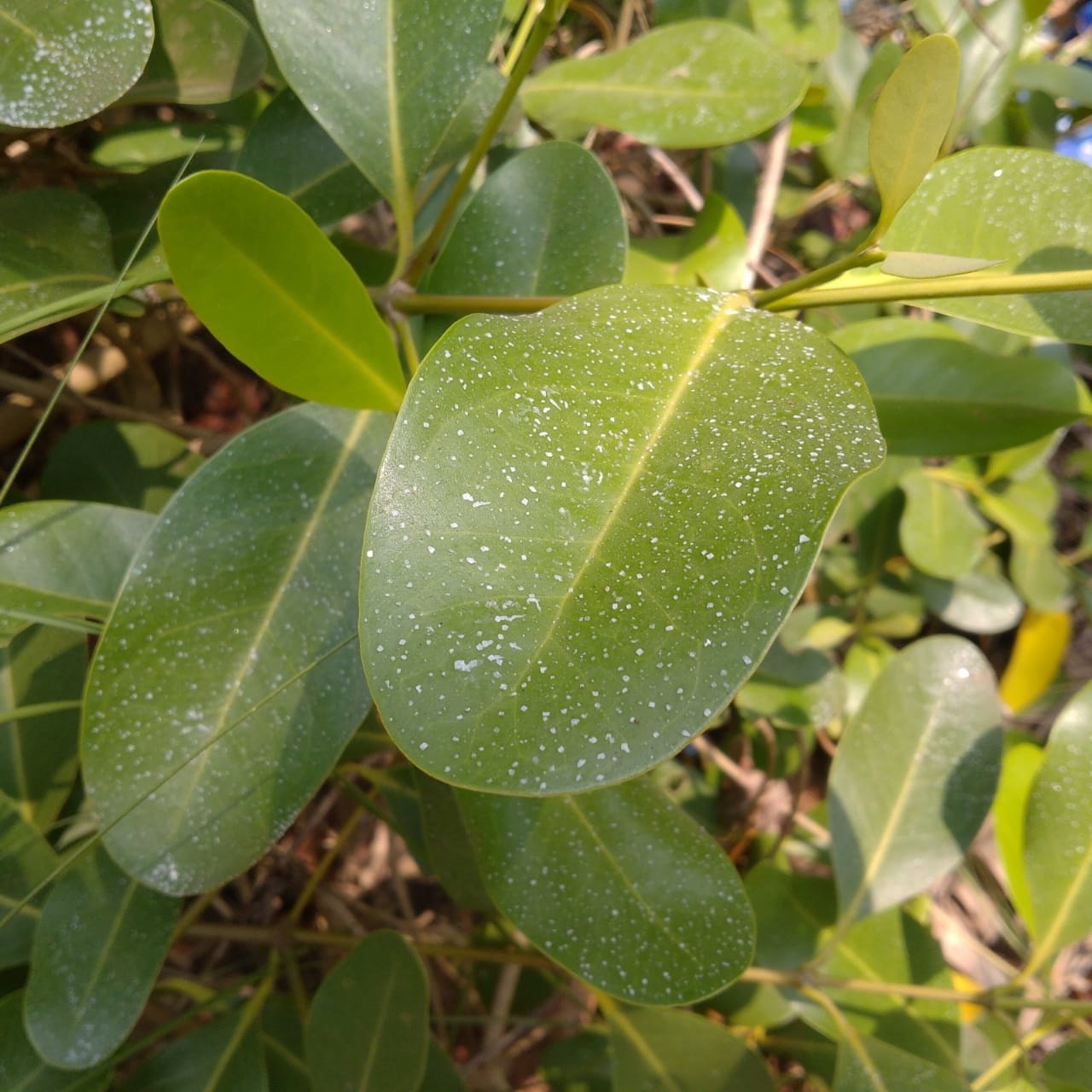 Avicennia officinalis is found sporadically on the banks of rivers and rarely found near the sea. It is an evergreen shrub or a tree, usually growing 8 -18 metres tall but exceptionally to 25 metres. Avicennia officinalis is found sporadically on the banks of rivers and rarely found near the sea. It is an evergreen shrub or a tree, usually growing 8 -18 metres tall but exceptionally to 25 metres.
They are salt-tolerant mangroves. The sap is salty, and excess salt is secreted through the leaves. They have spreading root system which provides support and stability. Vertical roots called pneumatophores project from the mud, thus the term “pencil roots. ” The flowers are fragrant and rich in nector, and are pollinated by insects. The embryos exhibit cryptovivipary, a process where they start to develop before the seed is shed. It is considered as a medicinal plant having several medicinal uses. Bark extract has antimicrobial property. |
|
| Avicennia marina(Forssk.)Vierh. |
|
| Family: Order Common name Vernacular name |
: Acanthaceae : Lamiales : Grey mangrove : ചെറു ഉപ്പട്ടി |
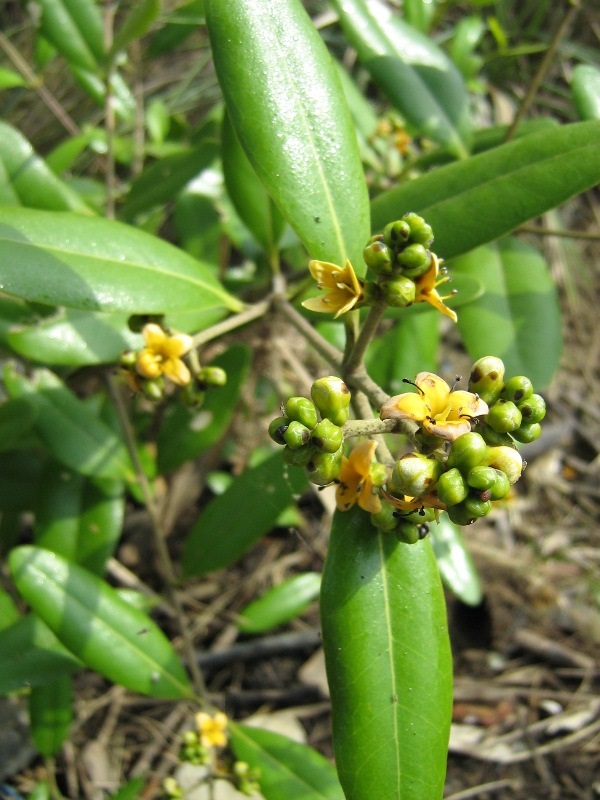 Avicennia marina is a shrub or tree. They are generally 10 -14 metre long and have light grey or whitish bark made up of thin, stiff, brittle flakes. They have aerial roots (pneumatophores). Avicennia marina is a shrub or tree. They are generally 10 -14 metre long and have light grey or whitish bark made up of thin, stiff, brittle flakes. They have aerial roots (pneumatophores).
A special feature of this plant is they can tolerate high salinity by excreting salts through its leaves. The excreted salt can be seen on the underside of leaves. The flowers range from white to a golden yellow colour and occur in clusters of three to five. The fruit contains large cotyledons. This produces a large, fleshy seed, often germinating on the tree and falling as a seedling. Flowers are fragrant with full of nectar to attract insects for pollination. |
|
| Excoecaria agallocha L. |
|
| Family Order Common name Vernacular name |
: Euphorbiaceae : Malpighiales : Blind-your -eye mangrove, Blinding tree : കണ്ണാംപൊട്ടി |
 Excoecaria agallocha is an ever green or deciduous unisexual tree that grows up to 20m in height.The male inflorescence is drooping, long and 5- 10 cm in length,while the female inflorescence is short, about 1-4 cm long.It is known as back mangrove, is found at higher elevation back away from the ocean where salinity is lower. Excoecaria agallocha is an ever green or deciduous unisexual tree that grows up to 20m in height.The male inflorescence is drooping, long and 5- 10 cm in length,while the female inflorescence is short, about 1-4 cm long.It is known as back mangrove, is found at higher elevation back away from the ocean where salinity is lower.
Most of the names refer to its toxic properties cause blindness when its latex comes into contact with the eyes. The milky latex of Excoecaria agallocha is very poisonous and powerfully irritant, which is not unusual in milky species of plants in the family euphorbiaceae . Contact with skin causes irritation and rapid blistering , slight contact with eyes can cause temporary blindness, hence the common names that refer to blindness. It is resilient mangrove species does not have salt glands and aerial roots.The female flower produce pink berry like fruits from March to October. This is the only member of the Euphorbiaceae family associated with mangroves. |
|
| Aegiceras corniculatum (L.) |
|
| Family: Order Common name Vernacular name |
: Primulaceae : Ericales : Black mangrove, river mangrove : പൂക്കണ്ടൽ |
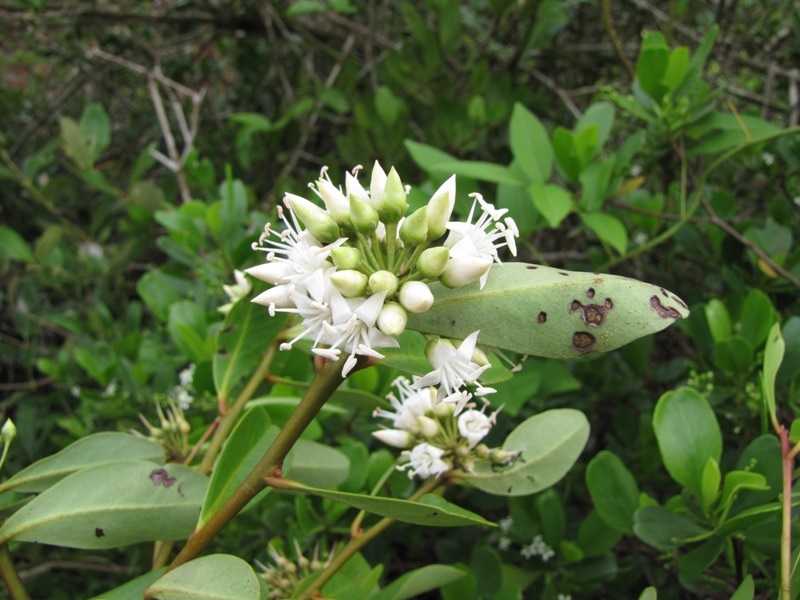 Aegiceras corniculatum is a species of shrub or tree mangrove in the primrose family with a distribution in coastal and esturine areas. Aegiceras corniculatum is a species of shrub or tree mangrove in the primrose family with a distribution in coastal and esturine areas.
These plants often grow together and can be up to 4m tall.There are glands on the leaves for secreting salt.It has fragrant, small, white flowers. Aegiceras corniculatum extract has analgesic properties which supports a fight against diabetes. |
|
| Sonneratia alba Sm |
|
| Family Order Common name Vernacular name |
: Lythraceae : Myrtales : Sweet-scented apple mangrove : നക്ഷത്രക്കണ്ടൽ |
 Sonneratia alba grows upto 4m tall with a trunk diameter up to 70cm. It is an evergreen tree with a broad spreading. The flowers are white, with pink at their base. The dark green fruits measure up to 5cm long. Sonneratia alba grows upto 4m tall with a trunk diameter up to 70cm. It is an evergreen tree with a broad spreading. The flowers are white, with pink at their base. The dark green fruits measure up to 5cm long.
The fruit is depressed globose with persisting style. The tree has several thick blunt pneumatophores. The plant is used as medicine for the treatment of injuries ,diarrhoea, wound and fever. |
|
| Acanthus ilicifolius L. |
|
| Family Order Common name Vernacular name |
: Acanthaceae : Lamiales : Holy-leaved acanthus, Sea holy : ചുള്ളിക്കണ്ടൽ |
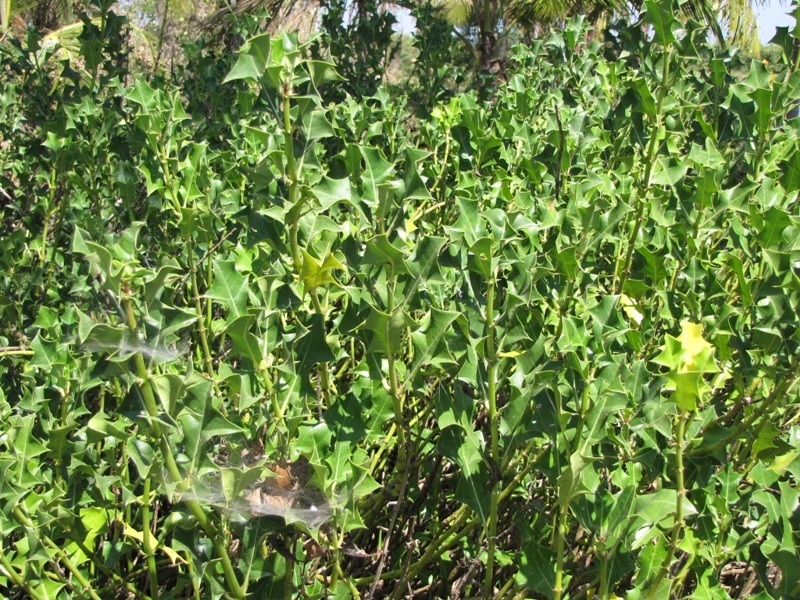 Acanthus ilicifolius is an erect or reclining ever green shrub ; grows to about one metre tall and produce adventitious roots. Acanthus ilicifolius is an erect or reclining ever green shrub ; grows to about one metre tall and produce adventitious roots.
Flowers blue or violet in a dense spike. Fruits are green- kidney shaped. The leaf margin pinnately lobed with poisonous and spinous tips. |
|












